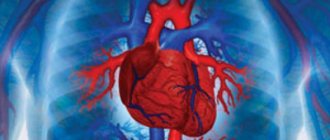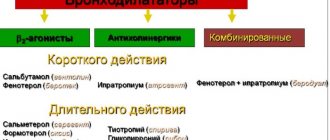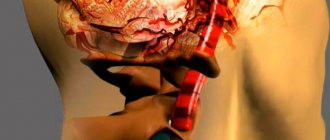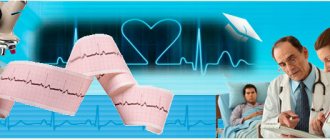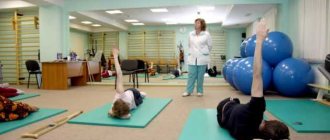Symptoms of heart disease
What are the symptoms of heart problems and how to distinguish one disease from another:
- With angina, painful sensations occur during physical activity, sometimes after excitement, alcohol, or heavy food. There is a feeling of heaviness, burning, compression behind the sternum on the left or in the heart area, destabilization of the rhythm. The attack passes in a few minutes. At rest there are no unpleasant sensations.
- Signs of myocardial infarction – pain spreading to the shoulders, arms, left side of the back, heaviness, shortness of breath, fatigue, weakness. Unlike angina, pain occurs at rest. Vomiting or nausea, or a feeling of panic may be present.
- Myocarditis has similar symptoms. With it, the patient also experiences headaches, constant physical and emotional malaise, and swelling develops.
But pain in the sternum is not always a signal that the “heart is acting up.” Pain radiating to the shoulder blades indicates a hypertensive crisis, injuries, and diseases of the respiratory system.
Types of pain
Correctly determining the nature of the pain will help the doctor determine the cause of the pain and provide the necessary assistance.
Excessive physical activity can cause aching or nagging pain. Bruises or injuries to the sternum can also cause similar sensations. In some cases, it may worsen to stabbing pain due to active diaphragm movements (when sneezing, coughing, deep breathing).
Inflammation of the lungs is accompanied by compressive pain, cough and fever.
Pneumonia spasms and discomfort when breathing deeply. Choking and coughing are accompanying symptoms of the disease.
Burning sensation occurs with heartburn . Poor nutrition can lead to a condition that requires treatment by taking appropriate medications. Myocardial infarction is characterized by the presence of sharp pain, which can radiate into the right shoulder. It is necessary to call an ambulance, as there is a threat to human life. With the pericardium, a dull squeezing pain occurs. Spasm of the right hypochondrium and difficulty breathing are accompanying symptoms of the disease.
Paroxysmal pain is characteristic of angina pectoris . Physical activity or a severe psychological condition is the cause of pain. A person feels a stabbing pain during cholelithiasis . Calling a doctor is necessary, as the symptoms may worsen and this will lead to serious health problems.
Acute pain in the right chest is one of the causes of liver problems . Any tension in the chest only increases the discomfort.
Important! If symptoms such as nausea, vomiting, arrhythmia, shortness of breath, fear of death are added to chest pain, you must urgently call a doctor, as this could be a myocardial infarction!
Other causes of chest pain
Assess whether there is hypothermia or cough (especially with sputum). If the chest hurts due to bronchitis, then the painful sensations spread to the back, when coughing the diaphragm is tense, the cough is severe.
With pneumonia, the heartbeat is rapid, shortness of breath and weakness are present. There are chills and high fever.
Do not ignore possible injuries to the thoracic area - fractured ribs, displacement of the vertebrae.
Intercostal neuralgia is characterized by acute, shooting, very severe pain, the focus of which can be felt with your fingers (unlike cases of lung or heart disease). It's difficult to breathe. This condition lasts for hours, or even days, again, in contrast to pain during angina or heart attack.
Causes of pain under the shoulder blades
If there is pain in the area of the shoulder blades, the cause is sought both in the back and spine, as well as in the heart, stomach, and abdominal organs. How to determine what it could be?
Pathological conditions of the spine
Painful sensations under the shoulder blades, between them make you think about the condition of the spine.
These problems could be:
- scoliosis;
- osteochondrosis;
- kyphosis;
- protrusion of the intervertebral disc in the thoracic region;
- spondyloarthrosis;
- intervertebral hernia of the thoracic region.
For diseases of the back and spine, pay attention to the nature of the pain. These are long-term unpleasant sensations, depending on many factors: almost absent in the morning, intensified in the evening. Turning the neck and placing the hands behind the back increases the pain. It reaches its peak at night, making it difficult to sleep. Exercises and physical activity do not bring relief.
Other symptoms of scoliosis, kyphosis, osteochondrosis: fatigue, lack of freedom of movement, stiffness. Curvatures in the spine are visible, the person is hunched over. Sometimes arms, legs, fingers go numb, headaches, heart problems begin, there is noise in the ears, and vision decreases.
In the later stages, in addition to the curvature of the spine, deformation of the chest is visible.
But the pain itself does not spread to other parts of the body, being localized between the shoulder blades.
Sharp, shooting pains and tingling indicate radiculitis. Inflammation (of tendons, muscles), and even tumors of the spine can also manifest themselves this way. In this case, the pain decreases slightly when lying down, and touching the lesion is extremely painful.
Back pain between the shoulder blades: causes
Reasons that may cause discomfort in this area of the back:
- trauma (pain syndrome often manifests itself precisely in post-traumatic periods, and a person may even forget about the injury or bruise)
- vertebral diseases (kyphosis, osteochondrosis, scoliosis, spondyloarthrosis, etc.)
- pathology of discs in the chest
- cardiovascular diseases
- muscle and tendon problems
- intercostal neuralgia
- pathology of internal organs (liver, lungs, gall bladder), which are often accompanied by fever
- infectious lesions (poliomyelitis, tuberculosis)
- metastases of malignant tumors
- impairment of physical activity (insufficient or excessive)
- stressful conditions
- manual procedures (eg, epidural anesthesia)
The pain can be of a different nature, depending on the factors that provoke it:
- sharp short - usually caused by vertebrogenic causes
- long-term - characteristic of age-related processes in the body or diseases of the chest organs
- acute , appearing unexpectedly after performing any action, usually of neural origin
- dull , aggravated by exercise or coughing - accompanies pathologies of the respiratory system; "painful" is associated with problems of ligaments or tendons
- with impact on other parts of the body characterizes disturbances in the functioning of internal organs
To identify the source of pain between the shoulder blades, a competent and thorough diagnosis is necessary.
Pain in the shoulder blades due to diseases of the abdominal organs
It is diagnosed by pain in the area of the shoulder blades and diseases of the stomach and other organs. Very often this is a stomach ulcer.
Its symptoms:
- back pain is localized in the area of the left shoulder blade;
- it appears after certain foods;
- after vomiting (which often has no objective reasons), the unpleasant sensations weaken;
- the appearance of pain is associated with seasonality;
- increasing pain sensations.
Pain under the left shoulder blade, radiating to the sternum and solar plexus area, combined with vomiting, depending on food intake, are the main signs of an ulcer.
Painful sensations in the shoulder blades, but already radiating to the right side of the back and chest, is a symptom of colic - hepatic or biliary. This pain is extremely severe, especially in the morning and at night. Also accompanied by vomiting and caused by food.
Violation of the diet, a large amount of fatty foods creates nervous excitement and pain.
Subphrenic abscess is an extremely unpleasant phenomenon caused by other organ disorders. Due to appendicitis or peritonitis, pus accumulates under the diaphragm. Acute pain in the area of the shoulder blades radiates to the arm, intensifies when inhaling, and the patient has a fever.
Diseases of the kidneys, duodenum, cholecystitis are manifested by nagging, aching pain under the right or left shoulder blade.
Back pain in the area of the spine between the shoulder blades
It happens that a person experiences unpleasant sensations of pain between the shoulder blades in the spine area. This pain is usually not severe because this part of the spine is inactive. Discomfort may increase during physical activity and palpation. If the pain does not radiate to other areas of the body, then most likely the cause is spinal problems.
We list the main ones:
Mechanical damage:
- dislocations in the spinal column
- vertebral displacement
- in the acute phase there is no leading symptom
- possible loss of sensation in some places
- motor activity is reduced
Kyphosis:
- the column is bent in the chest area
- possible formation of a “hump”
Scoliosis:
- the pole is tilted to the side
- obvious asymmetry of the body position
- accompanied by constant pain
- treatable in the early stages
Osteochondrosis:
- development occurs at the site of inflammation, damage to the intervertebral disc
- calcium salts are deposited
- joints lose their mobility, squeezing nerve fibers
- there is aching pain
- Possible difficulty breathing
- When straightening the body, a specific crunch may occur
- there is a sluggish inflammatory process
Intervertebral disc protrusion:
- the disk protrudes beyond the boundaries of the column
- pain is localized in the affected area
- is the initial stage of hernia formation
Hernia:
- formed due to disruption of the lining of the intervertebral disc
- one of the most dangerous pathologies of the spine
- nerve fibers are damaged
- spinal roots are compressed
Spondyloarthrosis – arthrosis of the intervertebral joints:
- has a chronic type
- symptoms similar to osteoporosis
- articular cartilage undergoes negative changes (thinner, loses elasticity)
- possible formation of outgrowths that damage surrounding vessels and tissues
Kyphoscoliosis:
- combination of signs of kyphosis with scoliosis
- treated at an early stage
Radiculitis:
- usually a consequence of other vertebral diseases
- there is acute pain
- inflammation occurs, pinching of the nerve roots in the spinal cord
- complete cure is possible only after the elimination of the underlying disease
Periarthrosis of the humerus:
- accompanied by stiffness of the brachialis muscle
- Sharp joint pain occurs when raising arms
- characterized by salt deposits
Neuralgic causes
Pain behind the sternum can also be caused by intercostal neuralgia. When coughing, the pain intensifies. Psychological disorders are unusually manifested - the heart compresses, there is a tingling sensation between the shoulder blades or under them, there is pressure, the pain goes to the neck, to the arm, to the belt area, to the groin.
Tightness of the muscles of the shoulder blade, between the shoulder blades or in adjacent areas also causes pain - unpleasant, pulling or sharply occurring with certain movements. Some mobility is generally inaccessible to such a patient. Paralysis of the muscles around the shoulder blade is sometimes caused by infections.
A pinched nerve in the vertebrae is extremely unpleasant, painful and greatly affects normal life.
Pain in the sternum and shoulder blades during pregnancy
Due to the greater load on the body in general and on the spine in particular, during pregnancy there is tension between the shoulder blades, in the chest, under the shoulder blades.
A shift in the center of gravity provokes painful sensations, but if the pregnant woman does not have elevated body temperature or increased fatigue, then everything is normal.
After rest the pain goes away.
If rest does not reduce pain, the temperature rises - this is a manifestation of serious diseases, for example, pyelonephritis or pneumonia. This is the reason to see a doctor.
The appearance or continuation of pain after childbirth
If pain in the shoulder blades or sternum in combination with other symptoms continues or appears after pregnancy, this indicates kyphosis, scoliosis (and similar problems with the spine) or disc protrusion.
Often, pregnant women or those who have given birth experience heartburn - one of its symptoms is a pain, a burning sensation between the shoulder blades and especially in the chest. In combination with bloating after fatty foods, this is a reason to visit a gastroenterologist.
This is how cholecystitis, biliary dyskinesia, pancreatitis, gastritis, and ulcers manifest themselves...
Causes of pain under the left shoulder blade from behind from the back Pain in the back under the left shoulder blade is a symptom inherent in various diseases. Before you take action and engage...
After childbirth, your back hurts between your shoulder blades
Quite often, women complain of pain between the shoulder blades that appears after the birth of a child. The main causes of discomfort are:
- Curvature of the spine (scoliosis, kyphosis), intervertebral hernia - if a woman had poor posture before pregnancy, then the period of bearing a child aggravates this process.
- Returning the spine to its normal, prenatal position - during pregnancy, the woman’s body was tilted back, the muscles adapt to this position. And going back to normal hurts.
- Hypertonicity of the muscles of the interscapular area - the lumbar part of the back was relaxed during pregnancy, the main load fell on the upper body, which caused muscle tension, which does not disappear immediately after childbirth.
- Intercostal neuralgia - pain can appear due to nervous tension during pregnancy and continue for some time.
- Birth trauma (displacement of joints) is, unfortunately, a common occurrence during labor.
- Excessive physical activity - carrying a baby, feeding in an uncomfortable position, moving heavy objects (strollers, things) often provoke pain in this area.
- Mastitis – pain in an inflamed breast in a nursing mother can radiate to the back in the interscapular area.
To relieve pain for a woman during the postpartum period, the following is recommended:
- Try not to bend over, position the changing table, crib, and bathtub at the required level.
- Avoid excessive physical activity.
- Do not refuse the help of loved ones and relatives. Many household chores can be entrusted to them.
- Be comfortable while feeding - in order to avoid excessive back strain, use a pillow, a footrest, and try feeding while lying down.
- Wear a special corset or bandage; your doctor should choose its size and shape.
- Do postpartum exercises. With your doctor's permission, perform special exercises aimed at restoring your back muscles.
- Normalize your weight - excess weight gained during pregnancy can cause interscapular back pain.
Which doctor should you go to for pain in the sternum and shoulder blades?
So, you feel one or more of the listed symptoms. The reasons for some of them are easy to determine, others are too vague.
Who to go to when the pain under the shoulder blade radiates to the sternum?
Most often, the referral is given by a therapist. It determines which organ is affected, the causes and extent of this damage.
If visiting a therapist is undesirable or the suffering is too severe, then it is better to go straight to the doctor who deals with this problem. How to determine this?
When in doubt, check the most serious, potentially detailed diseases first:
- heart problems;
- spinal tumors;
- lung diseases.
The cardiologist will send the patient for an ECG. The oncologist will assess the potential risks, and fluorography will identify lung diseases.
If you suspect problems in the gastrointestinal tract, then go to a gastroenterologist. Ulcers, colic and cholecystitis often manifest as pain under the shoulder blades, behind the sternum on the right or left, between the shoulder blades, etc. In diseases of the stomach, duodenum and pancreas, pain is accompanied by belching and bloating, and changes in stool.
A neurologist will solve many problems in the sternum and thoracic spine. You may need to visit a cardiologist, traumatologist and nephrologist. So if the cause of the pain is not entirely clear, then visiting a therapist will save time.
When to call an ambulance?
If, against the background of pain between the shoulder blades and in the sternum, a significant and prolonged increase in temperature appears; if the patient coughs up blood; if there is the slightest suspicion of an acute manifestation of heart disease, then do not wait for the morning, do not expect to go to the clinic by appointment, but call the hospital.
Diagnostics
If pain appears between the shoulder blades in the spine and radiates to the sternum, it is important to consult a doctor as soon as possible. This could be a surgeon, orthopedist or traumatologist. Sometimes, only on the basis of an external examination and questioning of the patient, a specialist can determine the causes of pain. But to confirm the diagnosis you will still need to undergo an examination. This may be an MRI, CT, X-ray or ultrasound of internal organs. If heart disease is suspected, an ECG is performed.
Sometimes it is very difficult to identify the cause of pain even on the basis of an examination, so you need to tell the doctor in detail about your feelings. It is important when pain appears, how severe it is, where it is localized, and what symptoms are accompanied. This will help you make a more accurate diagnosis and choose the right treatment.
Source: sustavik.com
How to deal with pain on your own
A common cause of pain in the sternum area is improper lifting of weights, colds and poor diet. First of all, identify the causes of pain and eliminate them from your life. If there is no acute condition, then you can eliminate the discomfort yourself.
Ointments and heating patches are popular. Some people make compresses according to traditional recipes. Don't forget that the inflammatory process worsens when heated! Such compresses, patches and creams are used only where there is definitely no inflammation.
Self-massage is useful, but if touching the painful part is unbearable, then it is better to refuse it. The massage is done with great care, it is better to contact a professional.
After watching the video, you will be able to understand both options for self-massage and help your loved ones.
Gentle exercise and light exercise will also help relieve muscle tension in the chest and back.
You can’t endure such pain for a long time, but it’s a bad idea to suppress the unpleasant sensations with painkillers. It is better to treat the underlying cause.
Prevention
There are no specific preventative measures for pain under the right shoulder blade. If the pain is caused by diseases of the internal organs, then the main thing is to ensure that it does not worsen.
If the pain is associated with neuralgic problems and muscle spasms . then, as a preventive measure, it is necessary to monitor muscle tension, perform a set of exercises, play sports, avoid hypothermia and exposure to drafts, and, if possible, attend physiotherapeutic procedures and massage sessions.
• pain intensifies with movement, tension, and palpation.
Treatment for a bruise is very simple. It is enough to provide the victim with peace, apply cold to the affected area in the first days, and then switch to warming procedures (alcohol compresses, warming ointments, iodine mesh).
But sometimes, under the signs of a bruise, there are other, more serious injuries affecting the spine. Therefore, in all doubtful cases, you need to visit the emergency room and perform a chest x-ray.
Vertebral fracture
In the thoracic region
vertebrae are quite rare. But this is where they are most dangerous, since in the thoracic vertebrae there is a fairly narrow canal for the spinal cord. If the latter is compressed by vertebral fragments, very serious disorders can develop.
Most often, a so-called compression fracture of the vertebrae occurs, when the bone substance in the vertebral body breaks and its height decreases. This type of fracture is the easiest, but it is very insidious. The pain between the shoulder blades at the time and after the injury can be very mild, and the victim believes that he received a simple bruise. But every day the pain becomes more and more intense, and this finally forces me to consult a traumatologist. It is very dangerous to be on your feet with a spinal injury. Any slight misalignment can cause spinal cord injury.
To accurately diagnose a vertebral compression fracture, chest radiography is used. An even more accurate technique is computed tomography. All patients with a spinal fracture should be immediately admitted to the hospital. They remain in traction for some time: to do this, the head end of the bed is raised and the victim is fixed to it by the armpits.
Vertebral dislocation
This is a condition when the upper vertebra is slightly displaced in relation to the lower one. In the thoracic region
and vertebral subluxations are rare, since the spinal column is immobile and the chest is a stable structure. In order for a subluxation of the thoracic vertebra to occur, it is necessary to receive a sufficiently severe injury. Displacement of a vertebra, leading to back pain between the shoulder blades, can also occur over time as a result of constant stress (a condition known as spondylolisthesis).
With subluxation of a vertebra in the thoracic region, the same symptoms are observed as with a fracture. A definitive diagnosis can only be made after radiography and computed tomography.
The treatment is also similar - traction on an inclined bed by the armpits. But treatment in this case does not last as long as with a fracture.
Main sources of pain
The chest contains many organs and structures that are potentially a source of discomfort:
- epidermis or skin;
- the middle and lower trapezius muscles often become a source of pain that spreads to the chest along the rib line;
- thoracic vertebrae (thoracic spine) - despite their close fit to each other and relative inactivity, they can wear out and become injured, causing back pain radiating to the sternum area;
- The thoracic aorta is the largest vessel that extends directly from the heart and carries blood to vital internal organs;
- the esophagus, in which many receptors and nerve fibers are located;
- the heart, malfunctions of which can provoke dull or sharp pains, radiating not only to the back and chest, but also to other parts of the body;
- lungs, which extremely rarely “hurt” in the literal sense, but can project pain into surrounding organs and tissues.
Finally, a huge number of nerve receptors, fibers and large great vessels are concentrated in the chest, which can also undergo pathological changes. Since they are located close to each other, the pain is rarely localized to one point.
Diseases of the internal organs located under the diaphragm: the liver and pancreas can also lead to pain, which is often called shingles, that is, spreading along one half of the body in front and behind.
Each organ, structure or tissue affected has unique symptoms that can be used to determine the true source of discomfort. Therefore, during the diagnosis, doctors try to find out all the features of the symptoms.
Back pain between shoulder blades, treatment
There is no universal single way to get rid of pain between the shoulder blades. Since treatment depends on which organ provokes the discomfort.
It should be noted that all experts are against self-medication without accurately determining the nature of the disease. At the same time, pay attention to what should not be done for pain between the shoulder blades without consulting a doctor:
- Warming the affected area. The cause of discomfort may be inflammation of an organ. Exposing the area to heat can increase swelling and cause a flare-up.
- Intense physical workout. Vigorous exercise during inflammatory processes can significantly worsen the condition and cause various complications.
The appearance of pain syndromes between the shoulder blades can be caused by many factors, which makes diagnosis very difficult.
Even experienced specialists are not always able to immediately determine the real causes of pain. In these cases, the method of differential diagnosis is used. The patient is prescribed a thorough examination, which may include:
- x-ray
- magnetic resonance imaging
- electrocardiogram
- blood analysis
After identifying the source of pain, appropriate therapy is prescribed, which usually includes:
- Taking medications (painkillers, anti-inflammatory, diuretics to relieve swelling)
- Physiotherapy (laser or ultrasound therapy, electrophoresis)
- Massage and manual treatments
- Physical therapy
- Spa treatment
For diseases of the internal organs, appropriate therapy is prescribed, and hospitalization is possible.
You should not think that the problem of back pain is incurable. It is important to consult a doctor in time to prescribe treatment. If you follow all the doctor’s recommendations, you will feel a significant improvement within a few days. Be healthy!
Sharp pain in the middle of the back, radiating to the chest
The pain, which is most strongly felt directly between the shoulder blades and in the middle of the sternum and is acute, requires special attention. It can occur for several reasons, including diseases and dysfunctions of the spine:
- osteochondrosis;
- intervertebral hernia;
- thoracic spine injuries;
- muscle spasms;
- neuralgia.
Also, the cause of unpleasant symptoms that are felt in the back and chest can be pathologies of the heart and blood vessels. Each disease has distinctive features by which the doctor can differentiate the pathology.
Pain due to osteochondrosis
Pain caused by osteochondrosis in the thoracic spine is blurred due to the lack of clear localization. Its peculiarity is that it appears periodically under certain conditions, and irradiation and accompanying symptoms often suggest diseases of the heart and other organs of the chest.
With this pathology, patients complain of the following unpleasant phenomena:
- shortened breathing, when it is impossible to take a deep breath;
- burning sensation in the muscles between the shoulder blades;
- numbness in the hands;
- muscle spasm, due to which pain can spread up to the neck and head;
- weakness in the arms;
- convulsive muscle contractions in the upper abdomen.
Sometimes osteochondrosis of the thoracic region is accompanied by dysfunction of the internal organs. The stomach especially often suffers from it. In this case, the disease is accompanied by pain in the epigastrium.
The main symptom by which thoracic osteochondrosis is determined is an exacerbation of pain in the morning. After waking up, you feel stiffness of movement, dull nagging pain, which weakens after a massage or warm-up. In the acute course of the disease, they subside at rest and intensify with movements and palpation of the ribs, which makes it possible to differentiate them from cardiac colic.
Pain due to intervertebral hernia
With a herniated intervertebral disc, pain in the thoracic region is highly intense. It is distinguished by the following features:
- exacerbation with any movement - raising arms, walking;
- shooting character;
- irradiation (spread) to the area of the shoulder blades and to the chest in the region of the heart;
- forced shortened, shallow breathing.
It is almost impossible to distinguish a herniated disc from osteochondrosis and other spinal diseases without special diagnostics, so if such symptoms appear, the patient will have to undergo a comprehensive examination.
Pain from thoracic spine injuries
Injuries are characterized by constantly present symptoms. Unlike inflammatory and destructive diseases of the spine, they cause long-lasting pain. In this case, discomfort can come either directly from the spine or from the muscles.
The severity and nature of pain in thoracic injuries depends on the injuries received:
- when muscles are stretched and deformed, patients describe them as dull pulling, spreading along the line of the spine and along the circumference of the chest along the line of the ribs;
- with a compression fracture of the spine, the pain is sharp and quite severe, accompanied by swelling above the fracture, difficulty breathing, tingling in the limbs, paresis (loss of sensitivity) and paralysis.
Since a compression fracture of the thoracic spine is often accompanied by damage to internal organs (lungs, heart or blood vessels), pain can also come from them. The following symptoms accompany such injuries:
- cyanosis (pallor or cyanosis of the nasolabial triangle and mucous membranes);
- acute respiratory failure;
- severe heart rhythm disturbances;
- a sharp decrease in blood pressure while maintaining high venous pressure.
The listed phenomena require immediate medical attention, because in addition to external injuries, the patient may have internal bleeding, which often ends in death.
Pain from muscle spasms
Myalgia, provoked by muscle spasms, appears after physical exertion or when the body is exposed to temperature (hypothermia, less often overheating). Often, muscle spasm occurs against the background of osteochondrosis: the body tries to protect mobile bone structures, immobilizing them by tensing the muscles. The pain in this condition can be either sharp or dull. It often spreads to the middle of the chest along the costal line, and in women it extends into the mammary gland.
A distinctive feature of myalgia is the formation of a lump at the site of the most intense pain. The symptom weakens only after massage or the use of special medications (analgesics and muscle relaxants).
Neuralgia pain
About a quarter of all cases of pain between the shoulder blades, radiating into the chest, are caused by pinched nerves. As a rule, they occur with osteochondrosis and hernia of the thoracic spine. What distinguishes them from other types is:
- shooting character;
- duration;
- lack of relief at rest;
- aggravation when trying to do a massage or warm-up;
- spread along the line of the ribs on one side - on the right or left, depending on which nerve process is pinched.
Neuralgic symptoms are complemented by sensory disturbances and a sensation of “pins and needles” in the hands.
Pain in diseases of the heart and blood vessels
Heart pain is quite easily differentiated from discomfort caused by damage to the spine, muscles and nerves. They are accompanied by a complex of accompanying symptoms, which include:
- uneven, shallow breathing;
- severe dizziness, weakness;
- cold sweat breaking out;
- sudden darkening of the eyes;
- confusion or complete loss of consciousness;
- paralysis of one half of the body.
With an acute heart attack or aortic dissection, fever and a cough with pink or bright red bloody sputum often occur. In most patients, pain radiates to the chest, arm, neck and face. However, in some patients, an unpleasant sensation radiates to the leg shortly before the appearance of obvious signs of cardiac catastrophe. This is explained by the separation of blood clots and their movement through the blood vessels from the periphery to the center.
Treatment of pain under the right shoulder blade
Pain is always the body’s way of saying that it’s not feeling well. When chest pain radiates to the shoulder blade, a person immediately begins to panic, suspecting a heart attack or cancer. Mixed with discomfort is fear. But the list of diseases that cause thoracalgia is very long. If chest pain radiates to the shoulder blade, there are many reasons, so self-medication should be completely excluded.
This symptom can develop with osteochondrosis, angina pectoris, hypertensive crisis, diseases of the spine or lungs, heart attacks, stomach ulcers, intercostal neuralgia. Even psychological problems give such symptoms.
Lung diseases
Pleurisy is inflammation of the lining of the lung. With this disease, chest pain radiates to the shoulder blade. It appears from the side of inflammation in the chest. Therefore, it can occur on the right and between the shoulder blades.
Algia necessarily intensifies with any effort, for example, when coughing or moving. The temperature rises and the general condition is disturbed, shortness of breath and a dry cough appear.
Pain between the shoulder blades indicates damage to the posterior pleura.
It can develop in any part of the spine. However, chest pain is more often a sign of cervical osteochondrosis. Physical inactivity, prolonged sitting, poor nutrition and other pathologies impair blood circulation in the vertebrae.
Often the vertebral discs become displaced and put pressure on the nerve endings, causing pain. More often, the disease occurs due to physical inactivity, in office workers who sit for hours in a motionless position with their heads bowed. Then a dull pain is felt not only in the neck, but also in the chest, shoulder, and radiates to the shoulder blade, more often on the left.
The fact that chest pain radiates to the scapula on the left is characteristic of cervical osteochondrosis. Numbness appears in the back of the head, pain that interferes with the movements of the spine and constrains them, intensifies when trying to turn the head. It can be long-lasting and make it difficult to fall asleep. After waking up, a person often complains of dizziness.
Pain can occur in the mammary gland, stomach, heart, but most often it is not associated with the spine. Thoracic osteochondrosis is difficult to diagnose. Signs of chest pain can vary greatly. Some ailments with this rule are characterized by the following symptoms:
- pain in the ribs, which intensifies when inhaling and is accompanied by a burning sensation;
- numbness in the hands;
- difficulty swallowing and stomach pain;
- discomfort in the right side;
- cramps in the calves;
- breast pain in women.
But on palpation there is pain at the base of the chest. Discomfort increases at night. Drawing and aching pain in the chest, extending under the shoulder blade on the left, is mistaken by many for heart pathology. Signs of scoliosis for an experienced specialist: the tone of the spinal muscles on both sides of the spine varies.
The disease can manifest itself constantly or periodically - it depends on the provoking moments. The pain occurs only on one side, in the intercostal spaces, but always radiates to the left shoulder blade. It is encircling in nature and increases with sharp inspiration, pressure and stress.
Provocateurs: incorrect posture for a long time, hypothermia, sudden stress. To distinguish cardialgia from intercostal pain, it is enough to measure blood pressure and pulse. In the latter case they do not change. In addition, the intensity of cardialgia does not depend on movements.
Heart diseases
Coronary heart disease has 2 forms – heart attack and angina. Angina is characterized by attacks of pain with pressure on the sternum; they last no more than 5 minutes, and they can be relieved with nitrates. Pain in the left chest can radiate under the left shoulder blade, into the left arm and into the area between the shoulder blades.
Myocardial infarction is also characterized by unpleasant sensations in the chest, between the shoulder blades, but they do not go away after validol and nitroglycerin and last a long time. Other differences from angina:
- severe pain between the breasts is possible, and the lower jaw may also hurt;
- fear of death appears;
- pressure is reduced;
- pale skin, cold sweat.
You need to call an ambulance immediately.
With gastrointestinal diseases, chest pain radiating to the shoulder blade is a common occurrence.
With a stomach ulcer, thoracalgia can be strong or aching, radiating to the left scapula and interscapular area. The pain may increase when eating certain foods. Other manifestations are also present: heartburn, belching of air, increased salivation, regurgitation.
Ulcerative pain is special in that it occurs after eating, during fasting or at night. Nausea and sour vomiting may occur, followed by relief.
Sometimes a person has chest pain on the left, radiating to the scapula, for no clear reason - against the background of an anxious mood, but is accompanied by fear and panic, with a feeling of lack of air.
Painful sensations can be observed in various parts of the body, but then gradually move to the neck, under the left shoulder blade, and arm. In such cases, you should contact a psychotherapist.
Only a neurologist can determine the exact cause of pain and numbness between the shoulder blades and in the chest. This symptom may occur when:
- pathologies of the spinal column - hernias, scoliosis and kyphosis, neuralgia;
- heart disease (coronary artery disease, pericarditis);
- liver diseases (hepatitis, etc.);
- gallbladder diseases (cholecystitis, etc.);
- lung diseases (pleurisy, pneumonia, etc.).
Pneumonia
The inflammation may involve one or both lungs. Chest pain radiates between the shoulder blades and occurs in the chest when the posterior parts of the lungs are affected. Unpleasant sensations often occur on the affected side, where there is inflammation.
Signs of pneumonia:
- coughing;
- At first the cough is dry, then becomes wet;
- heat;
- shortness of breath, chest pain.
Chest pain radiating under the scapula on the left can occur with left-sided damage to the lung tissue.
Pancreatitis
Thoracalgia can be observed in acute pancreatitis, radiating to the interscapular area, but in general they are of a girdling nature, which does not respond to analgesics. All this is accompanied by a feeling of heat, lack of appetite, flatulence, vomiting, nausea and diarrhea.
There is an accumulation of pus between the diaphragm and the lower internal organs. It occurs when an infection is introduced during abdominal surgery.
The chest pain is acute, radiating not only under and to the right shoulder blade, but also to the right hypochondrium and shoulder. When inhaling, the pain intensifies. The temperature is elevated, there is leukocytosis in the blood, the general condition is disturbed with signs of intoxication due to a purulent process.
The pain is dull in nature, occurs in the lumbar region on the right, spreads to the entire right half of the body: chest, back, hypochondrium. It is periodic in nature and occurs with nephritis or chronic pyelonephritis in stage II of the process, when the renal tissue is already sclerotic.
Urination is painful, frequent, with severe burning and pain. Against the background of low-grade fever, there may be chills and, less commonly, nausea.
With cholelithiasis, the pain is stabbing and cutting in nature - biliary colic. Most often occurs after eating fatty foods. It may be associated with spasm of the bladder muscles or with a stone stuck in the duct - blockage of the bile ducts.
Severe pain first appears in the right hypochondrium, then concentrates in the projection of the gallbladder. It can move into the chest, radiate to the heart, neck, right shoulder and shoulder blade, to the right eye or jaw.
This disease is characterized by dull pain in the form of attacks, but they do not reach such a degree of severity. At first it is localized in the epigastrium, but at the same time “stretches” under the right scapula. Moreover, this picture is so typical that experienced patients already know that inflammation has begun. In addition to pain, the temperature rises, jaundice, nausea and vomiting may occur.
Hepatic colic
Very reminiscent of an attack of cholecystitis. It also causes severe pain radiating under the right shoulder blade. But with renal colic there is no fever, vomiting or nausea.
Pericarditis
This is an infectious lesion of the serous membrane of the heart muscle with the development of inflammation in it. The pain is felt deep in the chest in the heart. It increases when the patient takes a horizontal position. The sensations are aching, strong, radiating to the shoulder blade, neck, arm.
Accompanied by shortness of breath, weakness, decreased blood pressure and the appearance of edema, increased temperature for a long time (within 37.1–38 degrees). A blood test shows inflammation.
The clinical picture is similar to a heart attack, so X-rays are required for differentiation.
Esophageal rupture
May occur with severe vomiting. Characterized by pain in the middle of the chest, with a return to the back - under and into the scapula, interscapular space. The pain is acute and intensifies with any effort or inhalation. Seeing a doctor should be urgent.
Tracheitis
With inflammation of the tracheal mucosa, pain appears in the center of the chest and moves to the right shoulder blade. It is sharp and burning. In addition to pain, all the symptoms of a cold appear: fever, hoarseness, sore throat, dryness.
Cancers
In oncology, pain appears already in the last stages of the disease. They vary in intensity, radiating to the back and between the shoulder blades. Localized on the affected side, radiating to the neck and shoulder. The intensity and duration vary. They can be transient or permanent.
Usually such patients are already very weakened and cachectic. Most often, chest pain is characteristic of cancer of the esophagus, lungs, breast cancer, pancreas and liver.
Pain in the chest and back under the shoulder blade can occur with a hernia of the diaphragm, tuberculosis, mastitis, myositis and costochondritis. If they appear after physical activity, treatment other than rest is not required.
With this pathology, internal organs (their upper part) can penetrate from the abdominal cavity into the thoracic cavity. In this case, the pain in the chest on the left radiates to the scapula. It is always accompanied by heartburn and worsens when lying down. When eating food, the condition worsens.
Tuberculosis
Dull and sharp girdling pain
Sometimes the pain covers the area between the shoulder blades, the chest, and the upper abdomen, which makes it impossible to explain their exact location and find the source of discomfort. Such pains are called shingles. Most often, their causes are pathologies of internal organs:
- cholecystitis;
- cholelithiasis;
- liver diseases, most often hepatitis or cirrhosis;
- pancreatitis;
- kidney stone disease;
- nephritis or pyelonephritis;
- pneumonia, pleurisy;
- viral infections (shingles);
- tumors of the chest organs (lungs, esophagus or liver).
These causes of discomfort between the shoulder blades with irradiation into the chest are much less common than pathologies of the spine and surrounding structures. All of these diseases have specific symptoms, according to which they can be diagnosed already during an interview with the patient.
Pain in diseases of the liver and gallbladder
Sharp or dull pain from the back, radiating to the lower part of the sternum, is often caused by inflammation of the walls of the gallbladder or liver pathologies. In most cases, such diseases are accompanied by:
- digestive disorders;
- yellowing of the skin, whites of the eyes and mucous membranes;
- pain that extends from under the right shoulder blade to the epigastric region;
- colic on the right under the ribs and in the upper abdomen.
In an acute inflammatory process, fever with increased temperature is possible. Hepatic colic is accompanied by profuse sweating, paleness of the skin and mucous membranes, and fainting.
Pain due to diseases of the pancreas
With pancreatitis, the pain is described by patients as girdling, spreading equally to the right and left of the epigastric part of the abdomen. At the same time, it is felt much stronger on the right. A distinctive symptom of pancreatitis is the lack of relief of discomfort at rest and when changing position. It also does not increase with coughing, tensing the abs or back muscles, or deep breathing.
Along with the described symptoms, patients experience digestive disorders, general weakness, neurological disorders in the form of depression, mood swings.
Pain due to kidney disease
In case of chronic or acute inflammation of the kidneys (pyelonephritis) at the stage of sclerotic changes, the discomfort is periodic, radiates under the shoulder blade and spreads to the lower part of the sternum and abdomen. The pain is often dull or aching, but not stabbing. Localization depends on which side the inflammatory process occurs on. The pathology is accompanied by low-grade fever (persistent increase in body temperature), discomfort during urination, and swelling. With kidney stones, urinary retention or bleeding from the urethra is possible.
Pain due to lung diseases
With pneumonia, pleurisy and tuberculosis, painful sensations between the shoulder blades with irradiation into the chest are aggravated during coughing, and are especially strongly felt when trying to take a deep breath or exhale completely. Breathing in patients with such diseases is often shallow. There is also a persistent increase in body temperature, fever, weakness and fatigue, and pale skin.
Pain from herpes zoster (herpes)
Signs by which it can be determined that pain between the shoulder blades spreading to the chest was caused by the herpes virus (shingles) are as follows:
- general malaise;
- slight increase in body temperature;
- muscle weakness on one side of the chest;
- impaired skin sensitivity along the affected nerve;
- specific herpes rashes on the stomach or along the ribs.
As the infection progresses, the blisters burst and crust over. Later, a pinkish scar remains in their place. The pain persists for a long time after the disappearance of external signs of the disease.
Pain due to tumors
Tumor processes in the chest organs, which may cause pain, in most cases have mild symptoms. Pain, if any, is weak and dull, present periodically, and does not have a clear localization. Indirect signs help to suspect such conditions: sudden and severe weight loss, general weakness, decreased immunity, multiple dysfunctions of internal organs, enlarged subclavian lymph nodes.
Whatever the cause of back pain spreading to the chest, each case requires differentiated diagnosis using laboratory and instrumental methods. Only in this way will the doctor be able to identify the true source of the unpleasant symptom and select effective treatment.
Osteochondrosis
The thoracic spine is the most common cause of back pain between the shoulder blades. Previously, this disease was considered age-related. Today, the initial stages of osteochondrosis are detected even in seven-year-old children.
Osteochondrosis is a degenerative disease that is characterized by the gradual development of disorders in the joints through which adjacent vertebrae are connected. Subsequently, an inflammatory process develops in this place, which involves surrounding tissues, including nerve roots. This is the cause of the development of back pain between the shoulder blades.
The development of osteochondrosis is promoted by congenital disorders of the structure of bones and cartilage, malnutrition, poor posture, excess body weight, a sedentary lifestyle, heavy loads on the spinal column, and prolonged exposure to a monotonous, tense position.
Back pain with osteochondrosis is aching and constant. They can become significantly worse with physical activity, sudden movements, even coughing and sneezing. In addition, there are other symptoms: 1. Pain in the chest, patients often characterize it with the words “the stake is standing.” Sometimes this symptom can be mistakenly interpreted as a sign of diseases of the internal organs, in particular the heart and lungs. 2. Feeling of weakness in the hands, numbness, tingling, “crawling” sensation. Most often, this sign indicates that thoracic osteochondrosis is combined with cervical osteochondrosis. 3. There may be disturbances in movements in the hands, difficulty breathing due to decreased mobility of the ribs. 4. When the patient straightens or raises his shoulders, he may feel a crunch.
The diagnosis of osteochondrosis of the thoracic spine is established after questioning and examining the patient by a doctor and performing x-rays. To treat the disease, medications, physical therapy, massage, physiotherapy, and special methods of traction of the spinal column are used. If conservative methods are ineffective, surgical intervention is planned. Osteochondrosis is treated by specialists such as a neurologist and an orthopedist.

